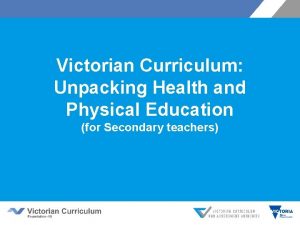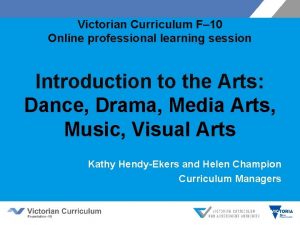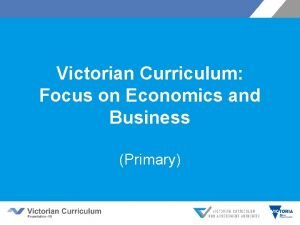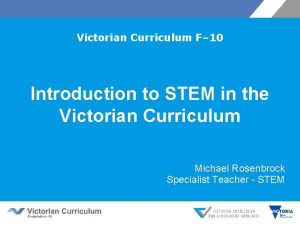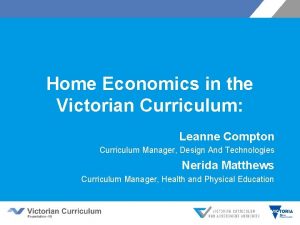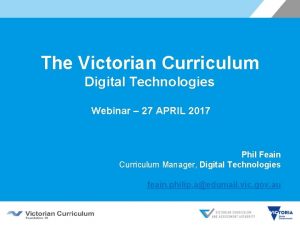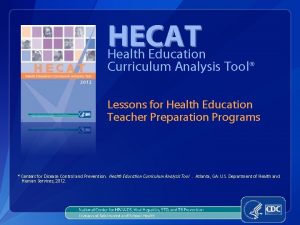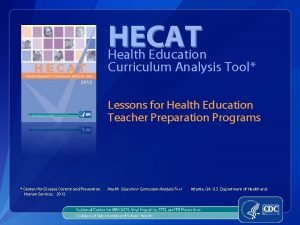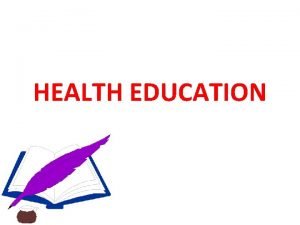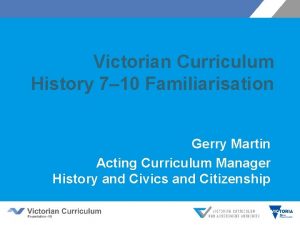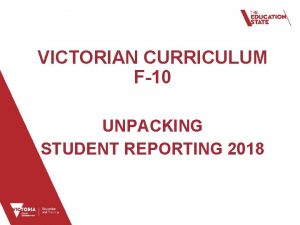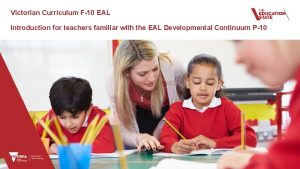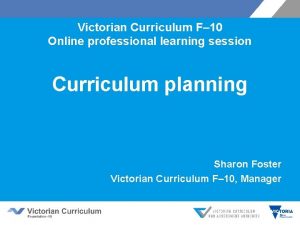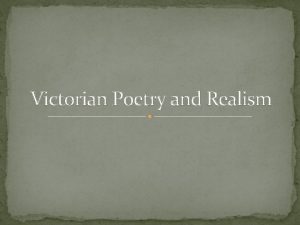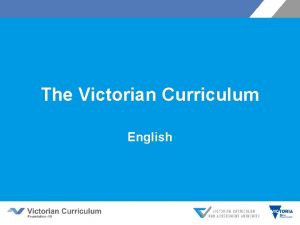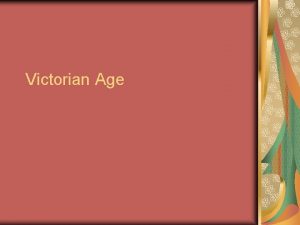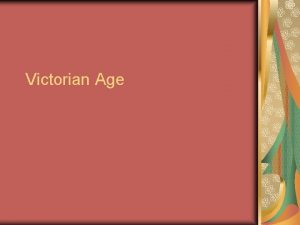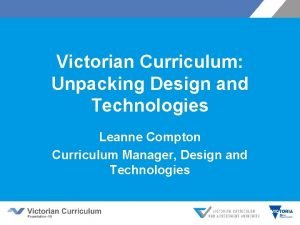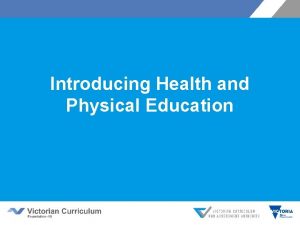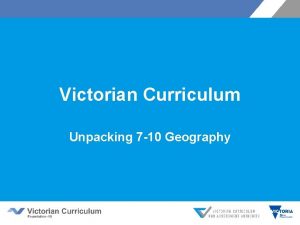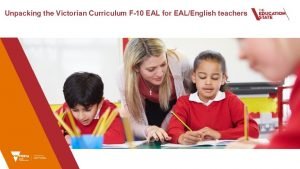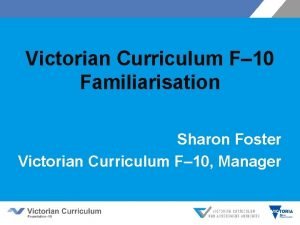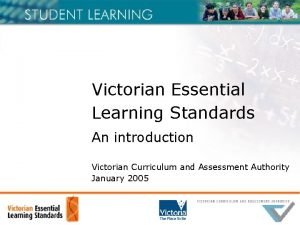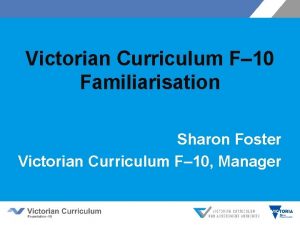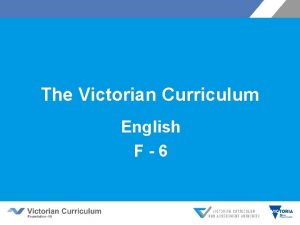Victorian Curriculum Unpacking Health and Physical Education for



















- Slides: 19

Victorian Curriculum: Unpacking Health and Physical Education (for Primary teachers)

Victorian Curriculum F– 10 • Released in September 2015 as a central component of the Education State • Provides a stable foundation for the development and implementation of whole-school teaching and learning programs • The Victorian Curriculum F– 10 incorporates the Australian Curriculum and reflects Victorian priorities and standards http: //victoriancurriculum. vcaa. vic. edu. au/

Terminology Aus. VELS - VELS component Victorian Curriculum Domains Curriculum areas Dimensions Strands and sub-strands ------- Content descriptions Learning focus ------- Standards Achievement standards

Structure Strands and sub-strands Strands Personal, Social and Community Health Movement and Physical Activity Sub-strands Being healthy, safe and active Moving the body Communicating and interacting for health and wellbeing Understanding movement Contributing to healthy and active communities Learning through movement Achievement standards • • The first achievement standard at Foundation and then at Levels 2, 4, 6, 8 and 10. A curriculum for students with disabilities is provided in this learning area.

Focus areas The focus areas provide the context through which the Content Descriptions and Achievement Standards are taught and assessed Alcohol and other drugs Active play and minor games (F-2 focusing on safe use of medicines) Food and nutrition Challenge and adventure activities (Starting at Level 3) Health benefits of physical activity Fundamental movement skills Mental health and wellbeing Games and sports (Starting at Level 3) Relationships and sexuality Lifelong physical activities (F-2 focusing on relationships) (Starting at Level 3) Safety Rhythmic and expressive movement

Focus areas application Levels 3 -4: Personal social and community health Content description Elaboration Identify and practise strategies to promote health, safety and wellbeing • identifying how medications and other substances can be stored safely in the home and at school (S, AD) • examining their own eating patterns by researching The Australian Guide to Healthy Eating and identifying healthier food choices (FN) • proposing changes they can make to their daily routines to reduce sedentary behaviour and increase physical activity levels (MH, HBPA) • explore and practise strategies that could be used to make the home and school environment safer (S) • identifying and practising ways of behaving in the playground that ensure the safety of themselves and others (S)

Focus areas application Levels 5 -6: Movement and Physical Activity Content description Elaboration Participate in physical activities designed to enhance fitness, and discuss the impact of regular participation on health and wellbeing • creating and participating in a fitness circuit designed to improve health-related fitness components (LLPA, HBPA) • demonstrating and describing safe stretching activities which maintain and develop flexibility (LLPA, HBPA) • examining the benefits of physical activity to social health and mental wellbeing (MH, HBPA, LLPA) • participating in a range of physical activities and exploring their health, skill and fitness benefits (FMS, GS, HBPA, CA, LLPA) • examining and describing health-related and skillrelated components of fitness (LLPA, HBPA)

Key messages Shaped by five interrelated propositions: • focuses on educative outcomes • takes a strengths-based approach • values movement • develops health literacy skills • includes a critical inquiry approach

Aims Health and Physical Education aims to develop the knowledge, understanding and skills to enable students to: • access, evaluate and synthesise information to take positive action to protect, enhance and advocate for their own and others’ health, wellbeing, safety and physical activity participation across their lifespan • develop and use personal, behavioural, social and cognitive skills and strategies to promote a sense of personal identity and wellbeing and to build and manage respectful relationships • acquire, apply and evaluate movement skills, concepts and strategies to respond confidently, competently and creatively in a variety of physical activity contexts and settings • engage in and enjoy regular movement-based learning experiences and understand appreciate their significance to personal, social, cultural, environmental and health practices and outcomes • analyse how varied and changing personal and contextual factors shape understanding of, and opportunities for, health and physical activity locally, regionally and globally.

Health and Physical Education Web Tour http: //www. vcaa. vic. edu. au/Pages/founda tion 10/f 10 index. aspx

Curriculum Planning Schools can decide how to structure their teaching and learning program. Content descriptions across the learning areas and capabilities can be combined to create teaching and learning programs. Schools will design teaching and learning programs to: • reflect local resources, expertise and contexts, and allows for specialisation and innovation • ensure every student has the opportunity to learn the knowledge, understandings and skills defined in the curriculum HPE resources, including Curriculum Mapping Templates: http: //www. vcaa. vic. edu. au/Pages/foundation 10/viccurriculum/hpe. aspx

Delivery in primary schools Modes of delivery of primary Health and Physical Education could include: • Physical Education taught by a specialist teacher • Health taught by the generalist classroom teacher • Health and Physical Education taught by the generalist classroom teacher • Other

Victorian Curriculum F-10 Revised curriculum planning and reporting guidelines http: //www. vcaa. vic. edu. au/Documents/viccurric/Revised F-10 Curriculum. Planning. Reporting. Guidelines. pdf

Foundation–Year 2 In Foundation to Year 2, schools are required to teach and report on four learning areas and one capability: • English • Mathematics • Health and Physical Education • The Arts • Personal and Social Capability

Years 3– 6 (in two-year bands) Schools teach and report on student achievement in each of the following curriculum areas during each two year band of school, in accordance with the whole school teaching and learning plan: • The Arts • Humanities: including History, Geography, Economics and Business (from Year 5 or 6), and Civics and Citizenship (from Year 3 or 4) • Technologies: including Design and Technologies and Digital Technologies • Capabilities: Critical and Creative Thinking, Intercultural, Ethical, and Personal and Social Capability • Languages • Health and Physical Education

Curriculum connections There are strong connections between HPE and other curriculum areas: • HPE and Personal and Social Capability together develop knowledge and skills to promote safe and respectful relationships • Design and technologies - Food specialisation • The Arts - Dance • Geography, Science and the Personal and Social Capability enable students to experience outdoor activities and to connect with the natural environment

Support for schools VCAA has employed specialist teachers to support schools implement the Victorian Curriculum in relation to Health Education and the Personal and Social Capability: • through development of resources (Term 1 and 2) • providing professional learning for schools (Term 3 onwards)

Questions?

Nerida Matthews Curriculum Manager, Health and Physical Education VCAA Phone: 90321721 Email: matthews. nerida. a@edumail. vic. gov. au
 Victorian curriculum hpe
Victorian curriculum hpe Victorian curriculum health and physical education
Victorian curriculum health and physical education Differentiate between health education and health promotion
Differentiate between health education and health promotion Egyptian time period floral design
Egyptian time period floral design Egyptian flower design
Egyptian flower design Victorian curriculum visual arts scope and sequence
Victorian curriculum visual arts scope and sequence Victorian curriculum business
Victorian curriculum business Critical and creative thinking vic curriculum
Critical and creative thinking vic curriculum History curriculum victoria
History curriculum victoria Victorian curriculum science scope and sequence
Victorian curriculum science scope and sequence Leanne compton
Leanne compton Digital technologies victorian curriculum
Digital technologies victorian curriculum Health education curriculum analysis tool
Health education curriculum analysis tool Cdc hecat
Cdc hecat Health education defination
Health education defination Unpacking and storing guest luggage
Unpacking and storing guest luggage Victorian curriculum history
Victorian curriculum history Victorian curriculum achievement standards
Victorian curriculum achievement standards Eal companion to victorian curriculum
Eal companion to victorian curriculum Progression points victorian curriculum english
Progression points victorian curriculum english

